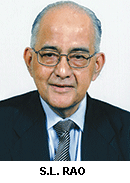It is generally accepted that every level of Indian education and research, from primary schools to universities, has very few institutions of high quality. The demographic dividend that India expects to leverage during the next 30 years is predicated on the young age of its population. The premise is that their youthful energy and high aspirations will make them productive and accelerate economic growth.
 Yet, the country’s youthful workforce must become better educated and acquire 21st century skills. Without these inputs, the ‘dividend’ will become a nightmare. Dissatisfied youth (either unemployed or in low paid casual work) will become restive and crime and criminality will increase. India will become a sick economy unless investment in education and skills development increases manifold. In effect, this means India must invest not merely to increase enrolments but also to upgrade education quality by producing trained faculty on a massive scale. Restricting this essay to higher education, it’s quite clear the most teaching and research is conducted in government-owned and controlled institutions, although some higher ed research-oriented institutions are privately owned.
Yet, the country’s youthful workforce must become better educated and acquire 21st century skills. Without these inputs, the ‘dividend’ will become a nightmare. Dissatisfied youth (either unemployed or in low paid casual work) will become restive and crime and criminality will increase. India will become a sick economy unless investment in education and skills development increases manifold. In effect, this means India must invest not merely to increase enrolments but also to upgrade education quality by producing trained faculty on a massive scale. Restricting this essay to higher education, it’s quite clear the most teaching and research is conducted in government-owned and controlled institutions, although some higher ed research-oriented institutions are privately owned.
Yet despite the country hosting 37,000 colleges and almost 800 universities, standards and ethics in education (including research) have been steadily declining. There’s an enormous dearth of adequately qualified teachers and researchers. There are too many faculty vacancies in engineering, medical and other professional education institutions with even the globally-renowned IITs experiencing a 35 percent shortage. Too few teachers are recruited and most have superficial knowledge of their subjects and minimal professional training. In addition to this dearth of qualified teachers, absenteeism is rife and teachers often delegate surrogates to teach. As a result, the majority of India’s poorly educated students are unready for jobs required in industry and services of the future.
To compound the numerous problems of higher education in India, administrative and supervisory bodies are rigid, bureaucratic, prescribe ill-researched, outdated curricula and discourage innovation. The University Grants Commission (UGC) which supervises liberal arts, sciences and commerce education, the All India Council for Technical Education (AICTE) which rigidly controls technical and professional education, and the Medical Council of India (MCI) have diminished, instead of raising, learning and research standards. Moreover, they have a penchant for creating new institutions by cloning the reputed ones, hurting the image of the originals. An IIM, IIT or AIIMS in each state is a noble dream. But great reputations take many years to build. They cannot be decreed without academic leadership, large-scale faculty training and recruitment and infrastructure development.
The country’s colleges and universities also need good governance. Therefore, scholars with administrative skills, leadership qualities, knowledge and competence should be appointed to institutional boards and governing councils, and vice chancellors must be appointed on the basis of competence rather than connections. Currently, the governing boards of universities tend to be packed with bureaucrats and small-time businessmen, notwithstanding the reality that they have little to contribute. Boards must be small, include people who are successful practitioners or specialists, and able to rejuvenate the systems and processes of academic institutions.
Due to acute supply-demand imbalances created in higher education by a plethora of licence-permit-quota rules and regulations legislated over decades for private higher — especially professional — education, profiteering and corruption are now common, especially in engineering and medical colleges/universities. Focused on micromanagement, few ‘independent’ regulatory bodies pay attention to learning outcomes and research output. At best, the UGC or ICSSR are money distributing organisations while AICTE, MCI etc, award recognition but do little to set and raise academic standards.
There’s a huge regulatory superstructure looming over the country’s schools, colleges and universities. A large HRD ministry at the Centre with many specialist departments is replicated in the states, and together they rigidly control government and private undergraduate engineering and medical colleges, B-schools and technology institutes. In addition, there is a plethora of regulatory bodies as well as advisory and training organisations — NCERT, NUEPA, UGC, AICTE, MCI, and separate legally mandated bodies for professional education in law, accounting, cost accounting, company secretarial practice and architecture.
With over-regulated and over-subsidised government colleges and universities in the dumps, middle and upper class students are migrating abroad or to a new genre of private universities with high tuition fee structures — by Indian standards. This phenomenon is exacerbating inequalities in society, adding class to caste and communal tensions.
The education system needs administrative and scholastic clean-up, and vastly more funds for faculty recruitment and training, and scholarships for poor students.